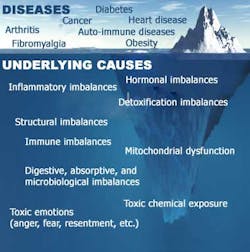Functional medicine is guided by six core principles: an understanding of the biochemical individuality of each human being, based on the concepts of genetic and environmental uniqueness; awareness of the evidence that supports a patient-centered rather than a disease centered approach to treatment; search for a dynamic balance among the internal and external body, mind, and spirit; familiarity with the web-like interconnections of internal physiological factors; identification of health as a positive vitality not merely the absence of disease emphasizing those factors that encourage the enhancement of a vigorous physiology; and promotion of organ reserve as the means to enhance the health span, not just the life span, of each patient.(6)
The development of Functional Dentistry was influenced by the revolutionary work and philosophies of the founder and chairman of Institute for Functional Medicine.(7) The mission of functional dentistry is to integrate dentistry into the other disciplines of healthcare so that all may gain a more comprehensive appreciation for the entire functioning human body.(7) Preventing disease and restoring health necessitates practitioners to be more like "architects of health" rather than specialists of single-entity systems.(8)
Named diseases are just the tip of the iceberg. Below the surface, according to Functional Medicine, are the real causes of a patient's health problems.
Whether to ascribe to the above concepts, I think we can all agree that prevention pays and there is a link between oral and general health. We know that oral bacteria that leak into the bloodstream are able to cause blood clots and trigger life-threatening endocarditis, according to researchers.(10)
Streptococcus gordonii
Streptococcus gordonii, a normal inhabitant of the mouth, is able to produce a molecule on its surface that allows it mimic the human protein fibrinogen, a blood-clotting factor. This activates the platelets, causing them to clump inside blood vessels. Platelet clumping can lead to growths on the heart valves (endocarditis), or inflammation of blood vessels that can block the blood supply to the heart or brain. Bottom line, prevention is the name of the game. Patient centered, evidence based care that is participatory and personalized is a goal for which we should strive.References 1. Pal, Sanjoy. "Complementary and alternative medicine: An overview." Current Science, Vol. 82, No. 5, 10 March 2002, 518-524. 2. Ehrlich, Gillian; Travis Callender, Barak Gaster (May 2013). "Integrative Medicine at Academic Health Centers: A Survey of Clinicians’ Educational Backgrounds and Practices." Family Medicine 45 (5): 330–334. 3. Galland L. Patient-centered care: antecedents, triggers, and mediators. Alternative Therapies in Health and Medicine 12 (4): 62–70. 2006. 4. Schimmel, Functional Medicine-The Origin and Treatment of Chronic Diseases, Karl F. Haug Verlag; Germany 1996. ISBN 3-7760-1635-3. 5. https://www.functionalmedicine.org/. 6. https://www.functionalmedicine.org/files/library/six-core-principles.pdf. 7. http://www.functionaldentistry.org/history.html. 8. http://www.functionaldentistry.org/mission.html. 9. http://www.yourmedicaldetective.com/public/department50.cfm. 10. Society for General Microbiology. "Dental plaque bacteria may trigger blood clots." ScienceDaily. ScienceDaily, 26 March 2012. www.sciencedaily.com/releases/2012/03/120326113436.htm.










